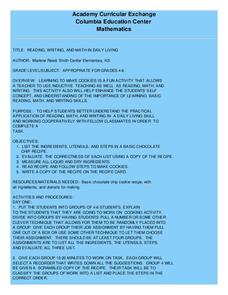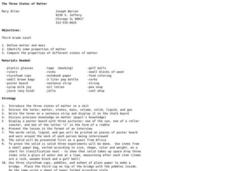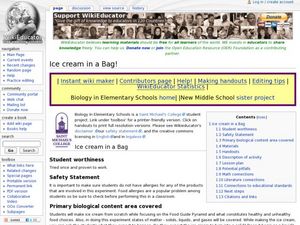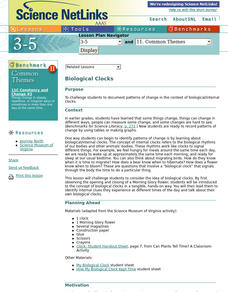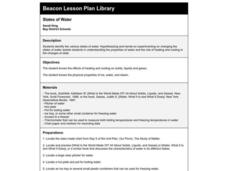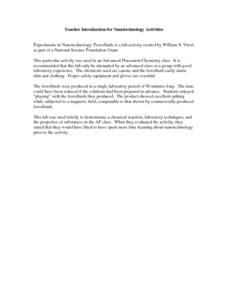Cornell University
Buoyancy
Swimmers know to float by turning their bodies horizontally rather than vertically, but why does that make a difference? In an interesting instructional activity, scholars explore buoyancy and the properties of air and water. They test...
Virginia Department of Education
The Particle Theory of Matter
Demonstrate the particle theory of matter to high school scientists with an engaging experiment that allows them to visually see the results as substances change from one state to another. The class concludes with a discussion about how...
Curated OER
Comparing Weights And Volumes
Students engage in a lesson that is focused upon the concept of weights and measures. They conduct experiments while classifying the quantities of different sized containers. Students compare and convert measurements like liters to...
Curated OER
Recipe Conversions-Enrichment Worksheet
A recipe for Chocolate Chewies, a no-bake cookie, is provided, but the ingredients are not written in useable amounts. Your cooking class must first convert them into useable amounts before preparing the treat. The final product acts as...
Teach Engineering
Capillarity – Measuring Surface Tension
How do cohesion and adhesion work together? The third installment of a nine-part series teaches young scientists the difference between adhesion and cohesion. They also learn how cohesion and adhesion work together to cause capillary...
Curated OER
Measure-mania
Students research the history of measurement in this lesson. They compare todays units of measurement to historical units of measurement. For example, they weigh themselves on a bathroom scale and figure out how many of them it would...
Curated OER
Teaching Matter with The Wild Christmas Reindeer
Second graders learn the proper way to take measurements, explore the properties of objects and expand their vocabulary.
Curated OER
Outrageous Ooze
Students examine states of matter. In this solids and liquids activity, students conduct a scientific investigation that requires them to make ooze and record their observations pertaining to it.
Curated OER
Properties of Matter
Third graders explore forms of matter through reading, hands-on science activities, and research using the Internet. Students create a booklet, directions given, that they title and decorate, to later serve as a review visualization...
Curated OER
Oobleck
First graders explore Oobleck. They manipulate and observe the properties of Oobleck. Students discuss the differences between solids and liquids. They investigate Oobleck. Students write a sentence describing what they observed about...
Curated OER
Reading, Writing, And Math in Daily Living
Students list ingredients, utenstils, and steps in basic chocolate chip recipe. They evaluate the correctness of each list using copy of recipe, measure all liquid and dry ingredients, read recipe and follow steps to make cookies.
Curated OER
A Matter of Fact
Third graders define matter as anything that takes up space and has mass, recognize, through experimentation and observation, that matter exists in three forms, including solid, liquid, and gas, and discuss characteristics of each form...
Curated OER
The Three States of Matter
Third graders identify properties of solids, liquids, and gasses. In this states of matter activity, the teacher demonstrates the properties of each state of matter, then students go on a scavenger hunt for items to represent each state...
Curated OER
Ice Cream in a Bag!
Students follow a recipe to make ice cream. In this ice cream lesson plan, students make their own ice cream by measuring out ingredients and following directions.
Curated OER
Water 1: Water and Ice
Students investigate water in its solid and liquid form. In this states of matter lesson, students experiment to see what happens as water goes from a solid, ice, to a liquid, water, and back again. They write about and illustrate the...
Curated OER
Slosh, Dribble, and Plop
Students recognize the need for a standard unit of volume. They estimate and measure to the nearest liter. Also they relate the liter to the familiar everyday containers.
Curated OER
Water and Ice
Students observe what happens to water as it goes from a solid to a liquid. In this exploratory lesson students gain an understanding for the water cycle while working in groups observing what happens to water as it changes...
Curated OER
Water and Ice
Students study the water cycle and the different forms of water. In this exploratory lesson plan students observe, measure and describe water as it changes state.
Curated OER
STATES OF WATER
Students identify the various states of water. They use hypothesizing and hands-on experimenting on changing the states of water, the properties of water, and the role of heating and cooling in the changes of state.
Curated OER
Experiments in Nanotechnology: Ferrofluids
Students explore the world of nanotechnology by synthesizing ferrofluids in a series of chemical reactions. In small groups, they follow the procedure to create the ferrofluids using precise measuring techniques. They test the resulting...
Curated OER
Fractions and Measuring in Cooking
Sixth graders explore cooking by creating food in class. In this ingredient measurement lesson, 6th graders discuss some of their favorite foods and review the proper recipes to cook them. Students utilize fractions to create a new...
Foundation for Water & Energy Education
What is the Water Cycle? Activity A
Hydrologists create a concept map about how water is used and a sentence strip defining water and describing its unique properties. Small groups work together to fill a small milk carton and compute the mass of water inside. The next...
Curated OER
Measuring With Graduated Cylinders
Students explore measuring with a graduated cylinder. In this measurement lesson, students observe liquids in a beaker. Students predict the volume of liquid in the beaker and then transfer the liquid to a graduated cylinder. Students...
Curated OER
Measuring Density
Students explore the concept of density. They use the the formula Density = Mass/Volume, one can determine where certain liquids and objects will settle in a graduated cylinder. In addiiton, they design a process to separate the liquids.






